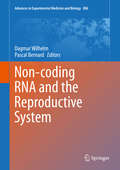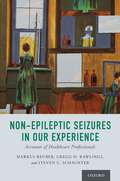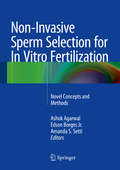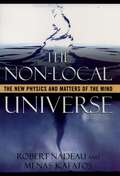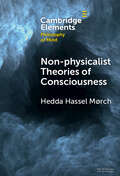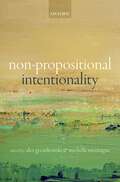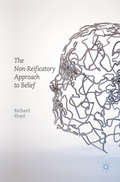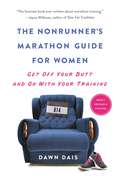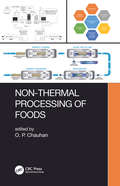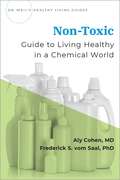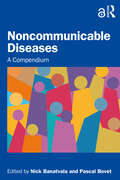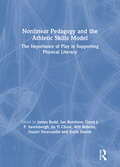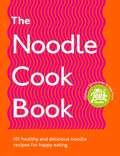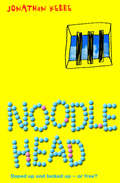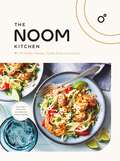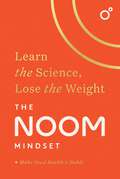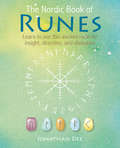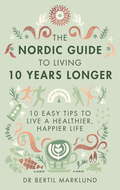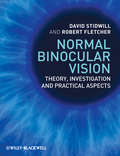- Table View
- List View
Non-coding RNA and the Reproductive System (Advances in Experimental Medicine and Biology #886)
by Dagmar Wilhelm Pascal BernardThis book provides an overview of the role and function of regulatory RNAs that lack protein-coding potential in key reproductive tissues. This includes the role of small interfering RNAs (siRNAs), microRNAs (miRNAs), PIWI-interacting RNAs (piRNAs), small nucleolar RNAs (snoRNAs) and long non-coding RNAs (lncRNAs). Through clear, detailed and comprehensive debate, international leading experts discuss the role these novel regulators in normal development of sexual dimorphisms, including the differentiation of ovaries and testes, the genital tract including prostate, epididymis and uterus, as well as mammary glands. In addition, particular attention is paid on their role in pathophysiological processes within the reproductive tract.The power of next generation sequencing has proved to be an invaluable tool to discover new non-coding RNAs. While the identification of non-coding RNA is relatively easy, analysing their function represents still a challenge today. In this book, authors present historical and conceptual background information, highlight the ways in which non-coding RNAs function is analysed and present their vision of the future research in their key research area.
Non-Epileptic Seizures in Our Experience: Accounts of Healthcare Professionals
by Steven C. SchachterTo an outside observer, Psychogenic Non-Epileptic Seizures (PNES) look like epileptic seizures. The manifestations of PNES include collapses, impaired consciousness, and seizure-related injuries. However, unlike epileptic seizures, which are the result of abnormal electrical discharges in the brain, most PNES are an automatic psychological response to a trigger perceived as threatening. Not least because the changes in the brain that underpin PNES cannot be visualised easily with clinical tests (such as the EEG), there are many uncertainties and controversies surrounding the condition. Patients often provoke a mixture of emotions in healthcare professionals. In the authors' previous book, In Our Words: Personal Accounts of Living with Non-Epileptic Seizures, over 100 individuals with PNES and their family wrote about their experiences with the condition. While some had positive care experiences, many were left feeling confused, angry, and abandoned by the clinicians they had encountered. Non-Epileptic Seizures in Our Experience: Accounts of Health Care Professionals complements the authors' previous book by presenting the perspectives of over 90 members of different healthcare professions from around the world. The anonymous publication format has enabled many not only to share success stories but also to be open about difficulties and failures. This volume will be an invaluable resource for both highly experienced professionals as well as relative novice and those experiencing PNES. This book will challenge negative attitudes surrounding the condition, improve understanding between healthcare professionals and patients, and - ultimately - advance the quality of care provided for those with PNES.
Non-Epileptic Seizures in Our Experience: Accounts of Healthcare Professionals
by Steven C. SchachterTo an outside observer, Psychogenic Non-Epileptic Seizures (PNES) look like epileptic seizures. The manifestations of PNES include collapses, impaired consciousness, and seizure-related injuries. However, unlike epileptic seizures, which are the result of abnormal electrical discharges in the brain, most PNES are an automatic psychological response to a trigger perceived as threatening. Not least because the changes in the brain that underpin PNES cannot be visualised easily with clinical tests (such as the EEG), there are many uncertainties and controversies surrounding the condition. Patients often provoke a mixture of emotions in healthcare professionals. In the authors' previous book, In Our Words: Personal Accounts of Living with Non-Epileptic Seizures, over 100 individuals with PNES and their family wrote about their experiences with the condition. While some had positive care experiences, many were left feeling confused, angry, and abandoned by the clinicians they had encountered. Non-Epileptic Seizures in Our Experience: Accounts of Health Care Professionals complements the authors' previous book by presenting the perspectives of over 90 members of different healthcare professions from around the world. The anonymous publication format has enabled many not only to share success stories but also to be open about difficulties and failures. This volume will be an invaluable resource for both highly experienced professionals as well as relative novice and those experiencing PNES. This book will challenge negative attitudes surrounding the condition, improve understanding between healthcare professionals and patients, and - ultimately - advance the quality of care provided for those with PNES.
Non-Invasive Sperm Selection for In Vitro Fertilization: Novel Concepts and Methods
by Ashok Agarwal Edson Borges Amanda S. SettiNon-Invasive Sperm Selection for In Vitro Fertilization summarizes and discusses the relevant literature on the various advanced sperm selection methods used in modern Assisted Reproductive Technologies (ART). Chapters review some of the major unresolved issues in the field, the feasibility and success of the various sperm selection methods, their safety and the effects they have on sperm quality and ART outcomes. The book makes recommendations on clinical applications and future research, while helping to elucidate the benefits and promise of non-invasive sperm selection techniques. A distinguished team of scientists, embryologists, and urologists, with expertise in male infertility and ART, contributes to this original and valuable reference guide meant for academics, researchers, and professionals in the field of reproductive medicine who need an update on the current status of the study and practice of non-invasive sperm selection techniques.
The Non-Local Universe: The New Physics and Matters of the Mind
by Robert Nadeau Menas KafatosClassical physics states that physical reality is local--a point in space cannot influence another point beyond a relatively short distance. However, In 1997, experiments were conducted in which light particles (photons) originated under certain conditions and traveled in opposite directions to detectors located about seven miles apart. The amazing results indicated that the photons "interacted" or "communicated" with one another instantly or "in no time." Since a distance of seven miles is quite vast in quantum physics, this led physicists to an extraordinary conclusion--even if experiments could somehow be conducted in which the distance between the detectors was half-way across the known universe, the results would indicate that interaction or communication between the photons would be instantaneous. What was revealed in these little-known experiments in 1997 is that physical reality is non-local--a discovery that Robert Nadeau and Menas Kafatos view as "the most momentous in the history of science." In The Non-Local Universe, Nadeau and Kafatos offer a revolutionary look at the breathtaking implications of non-locality. They argue that since every particle in the universe has been "entangled" with other particles like the two photons in the 1997 experiments, physical reality on the most basic level is an undivided wholeness. In addition to demonstrating that physical processes are vastly interdependent and interactive, they also show that more complex systems in both physics and biology display emergent properties and/or behaviors that cannot be explained in the terms of the sum of parts. One of the most startling implications of non-locality in human terms, claim the authors, is that there is no longer any basis for believing in the stark division between mind and world that has preoccupied much of western thought since the seventeenth century. And they also make a convincing case that human consciousness can now be viewed as emergent from and seamlessly connected with the entire cosmos. In pursuing this groundbreaking argument, the authors not only provide a fascinating history of developments that led to the discovery of non-locality and the sometimes heated debate between the great scientists responsible for these discoveries. They also argue that advances in scientific knowledge have further eroded the boundaries between physics and biology, and that recent studies on the evolution of the human brain suggest that the logical foundations of mathematics and ordinary language are much more similar than we previously imagined. What this new knowledge reveals, the authors conclude, is that the connection between mind and nature is far more intimate than we previously dared to imagine. What they offer is a revolutionary look at the implications of non-locality, implications that reach deep into that most intimate aspect of humanity--consciousness.
Non-physicalist Theories of Consciousness (Elements in Philosophy of Mind)
by null Hedda Hassel MørchIs consciousness a purely physical phenomenon? Most contemporary philosophers and theorists hold that it is, and take this to be supported by modern science. But a significant minority endorse non-physicalist theories such as dualism, idealism and panpsychism, among other reasons because it may seem impossible to fully explain consciousness, or capture what it's like to be in conscious states (such as seeing red, or being in pain), in physical terms. This Element will introduce the main non-physicalist theories of consciousness and explain the most important arguments for them, and consider how they each respond to the scientific and other arguments in support of physicalism. This title is also available as Open Access on Cambridge Core.
Non-Propositional Intentionality
by Michelle Montague Alex GrzankowskiThe mind is directed upon the world. There are worldly things that we have beliefs about and things in the world we desire to have happen. We find some things fearsome and others likable. The puzzle of intentionality — how it is that our minds make contact with the world — is one of the oldest and most vexed issues facing philosophers. Many contemporary philosophers and cognitive scientists have been attracted to the idea that our minds represent the world. This book explores an important assumption about representation, namely, that when we represent things in the world, we represent them as having properties, and in this way our representations have "propositional" structure. The contributors examine what the commitment to propositionalism amounts to; illuminate why one might find the thesis attractive (or unattractive); and consider ways in which one might depart from propositionalism. The hope is that this will lead towards a more complete understanding of how the mind and world are connected.
Non-Propositional Intentionality
The mind is directed upon the world. There are worldly things that we have beliefs about and things in the world we desire to have happen. We find some things fearsome and others likable. The puzzle of intentionality — how it is that our minds make contact with the world — is one of the oldest and most vexed issues facing philosophers. Many contemporary philosophers and cognitive scientists have been attracted to the idea that our minds represent the world. This book explores an important assumption about representation, namely, that when we represent things in the world, we represent them as having properties, and in this way our representations have "propositional" structure. The contributors examine what the commitment to propositionalism amounts to; illuminate why one might find the thesis attractive (or unattractive); and consider ways in which one might depart from propositionalism. The hope is that this will lead towards a more complete understanding of how the mind and world are connected.
The Non-Reificatory Approach to Belief
by Richard FloydThis book argues against the mainstream view that we should treat propositional attitudes as internal states, suggesting that to treat beliefs as things of certain sort (i.e. to reify them) is a mistake. The reificatory view faces several problems that the non-reificatory view avoids, and it is argued the non-reificatory view is more faithful to the everyday concept of belief. There are several major reasons why it might be thought that a reificatory approach to mental states is nevertheless unavoidable, but this book attempts to show that none of these reasons is at all convincing; in each case, the evidence is consistent with a non-reificatory view. Having argued that the popularity of the reificatory view is unjustified, the author examines history of psychology and philosophy of mind, and the structure of psychological language, in order to show that this popularity is quite understandable, but mistaken nonetheless.
The Non-Reificatory Approach to Belief
by Richard FloydThis book argues against the mainstream view that we should treat propositional attitudes as internal states, suggesting that to treat beliefs as things of certain sort (i.e. to reify them) is a mistake. The reificatory view faces several problems that the non-reificatory view avoids, and it is argued the non-reificatory view is more faithful to the everyday concept of belief. There are several major reasons why it might be thought that a reificatory approach to mental states is nevertheless unavoidable, but this book attempts to show that none of these reasons is at all convincing; in each case, the evidence is consistent with a non-reificatory view. Having argued that the popularity of the reificatory view is unjustified, the author examines history of psychology and philosophy of mind, and the structure of psychological language, in order to show that this popularity is quite understandable, but mistaken nonetheless.
The Non Runner’s Marathon Guide for Women: Get Off Your Butt And On With Your Training
by Dawn DaisDawn Dais hated running. And it didn't like her much, either. Her fitness routine consisted of avoiding the stairs in her own house, because who really has the energy to climb stairs? It was with this exercise philosophy firmly in place that she set off to complete a marathon. The Nonrunner's Marathon Guide for Women is a fun training manual for women who don't believe that running is their biological destiny but who dream of crossing the finish line nonetheless. Dais' audiobook features a realistic training schedule and is chock-full of how-to's and funny observations, which she felt were lacking in the guides she had consulted. She also integrates entries from her journal, sharing everything would-be marathoners need to know about the gear, the blisters, the early morning workouts, the late-night carb binges, and, most important of all, the amazing rewards. Anyone can do a marathon. This audiobook just makes the experience a little more bearable and a lot more fun.
Non-thermal Processing of Foods
by O. P. ChauhanThis book presents the latest developments in the area of non-thermal preservation of foods and covers various topics such as high-pressure processing, pulsed electric field processing, pulsed light processing, ozone processing, electron beam processing, pulsed magnetic field, ultrasonics, and plasma processing. Non-thermal Processing of Foods discusses the use of non-thermal processing on commodities such as fruits and vegetables, cereal products, meat, fish and poultry, and milk and milk products. Features: Provides latest information regarding the use of non-thermal processing of food products Provides information about most of the non-thermal technologies available for food processing Covers food products such as fruits and vegetables, cereal products, meat, fish and poultry, and milk and milk products Discusses the packaging requirements for foods processed with non-thermal techniques The effects of non-thermal processing on vital food components, enzymes and microorganisms is also discussed. Safety aspects and packaging requirements for non-thermal processed foods are also presented. Rounding out coverage of this technology are chapters that cover commercialization, regulatory issues and consumer acceptance of foods processed with non-thermal techniques. The future trends of non-thermal processing are also investigated. Food scientists and food engineers, food regulatory agencies, food industry personnel and academia (including graduate students) will find valuable information in this book. Food product developers and food processors will also benefit from this book.
Non-Toxic: Guide to Living Healthy in a Chemical World (Dr Weil's Healthy Living Guides)
by Aly Cohen Frederick vom SaalThere is no question that our environment has changed dramatically over the past few decades. The influx of thousands of toxic chemicals that seep into every aspect of our lives wreaking havoc on our bodies can seem daunting, but research now shows that by making simple changes, we can dramatically reduce exposures to many harmful chemicals that we eat, breathe, and lather on our skin. Non-Toxic is a practical guide to living healthier in our modern environment. It teaches how to reduce chemical and radiation exposures by recognizing potential threats and paying attention to what you eat, breathe, and put onto your skin. Written in clear, easy-to-understand language and based on scientific evidence, this book is filled with resources, tools, tear-off sheets, recipes, and practical, cost-effective tips designed to help you: · Understand and decode product and food labels · Create delicious recipes to help detoxify your body · Choose and prepare food and drinks safely and healthfully · Furnish and clean your home for a healthy indoor environment · Safely disinfect surfaces from COVID-19 · Create do-it-yourself cleaning product recipes · Choose safer personal care products and cosmetics · Reduce exposure to pesticides in and around your home · Ensure safe drinking water for you, your family and pets · Reduce exposure to EMF radiation from cell phones, laptops and other tech toys · Make informed decisions about toys, baby products, and other environmental issues affecting your children Written by a board-certified Rheumatologist and Integrative Medicine Physician, and a renowned PhD professor of neuro- and reproductive biology, Non-Toxic is designed to be referred to again and again for its relevant, cost-effective, and practical ways to reduce exposure and thereby lower risk for developing a variety of environmentally associated illnesses. ABOUT THE SERIES: From series editor, Andrew Weil, one of the most iconic and trusted names in healthcare today, the Dr. Weil's Healthy Living Guides series discusses caring for common medical conditions and optimizing health from an integrative medical approach. Integrative medicine is defined as an evidence-based healing-oriented medicine that takes account of the whole person (body, mind, and spirit), including all aspects of lifestyle. It emphasizes the therapeutic relationship and makes use of all appropriate therapies, conventional, alternative, and complementary.
Non-Toxic: Guide to Living Healthy in a Chemical World (Dr Weil's Healthy Living Guides)
by Aly Cohen Frederick vom SaalThere is no question that our environment has changed dramatically over the past few decades. The influx of thousands of toxic chemicals that seep into every aspect of our lives wreaking havoc on our bodies can seem daunting, but research now shows that by making simple changes, we can dramatically reduce exposures to many harmful chemicals that we eat, breathe, and lather on our skin. Non-Toxic is a practical guide to living healthier in our modern environment. It teaches how to reduce chemical and radiation exposures by recognizing potential threats and paying attention to what you eat, breathe, and put onto your skin. Written in clear, easy-to-understand language and based on scientific evidence, this book is filled with resources, tools, tear-off sheets, recipes, and practical, cost-effective tips designed to help you: · Understand and decode product and food labels · Create delicious recipes to help detoxify your body · Choose and prepare food and drinks safely and healthfully · Furnish and clean your home for a healthy indoor environment · Safely disinfect surfaces from COVID-19 · Create do-it-yourself cleaning product recipes · Choose safer personal care products and cosmetics · Reduce exposure to pesticides in and around your home · Ensure safe drinking water for you, your family and pets · Reduce exposure to EMF radiation from cell phones, laptops and other tech toys · Make informed decisions about toys, baby products, and other environmental issues affecting your children Written by a board-certified Rheumatologist and Integrative Medicine Physician, and a renowned PhD professor of neuro- and reproductive biology, Non-Toxic is designed to be referred to again and again for its relevant, cost-effective, and practical ways to reduce exposure and thereby lower risk for developing a variety of environmentally associated illnesses. ABOUT THE SERIES: From series editor, Andrew Weil, one of the most iconic and trusted names in healthcare today, the Dr. Weil's Healthy Living Guides series discusses caring for common medical conditions and optimizing health from an integrative medical approach. Integrative medicine is defined as an evidence-based healing-oriented medicine that takes account of the whole person (body, mind, and spirit), including all aspects of lifestyle. It emphasizes the therapeutic relationship and makes use of all appropriate therapies, conventional, alternative, and complementary.
Noncommunicable Diseases: A Compendium
by Nick Banatvala Pascal BovetNoncommunicable Diseases: A Compendium introduces readers to noncommunicable diseases (NCDs) – what they are, their burden, their determinants and how they can be prevented and controlled. Focusing on cardiovascular disease, diabetes, cancer and chronic respiratory disease and their five shared main risk factors (tobacco use, harmful use of alcohol, unhealthy diet, physical inactivity and air pollution) as defined by the United Nations, this book provides a synopsis of one of the world’s biggest challenges of the 21st century. NCDs prematurely claim the lives of millions of people across the world every year, with untold suffering to hundreds of millions more, trapping many people in poverty and curtailing economic growth and sustainable development. While resources between and within countries largely differ, the key principles of surveillance, prevention and management apply to all countries, as does the need to focus resources on the most cost-effective and affordable interventions and the need for strong political will, sufficient resources, and sustained and broad partnerships. This compendium consists of 59 short and accessible chapters in six sections: (i) describing and measuring the burden and impact of NCDs; (ii) the burden, epidemiology and priority interventions for individual NCDs; (iii) social determinants and risk factors for NCDs and priority interventions; (iv) global policy; (v) cross-cutting issues; and (vi) stakeholder action. Drawing on the expertise of a large and diverse team of internationally renowned policy and academic experts, the book describes the key epidemiologic features of NCDs and evidence-based interventions in a concise manner that will be useful for policymakers across all parts of society, as well as for public health and clinical practitioners.
Noncommunicable Diseases: A Compendium
by Nick Banatvala and Pascal BovetNoncommunicable Diseases: A Compendium introduces readers to noncommunicable diseases (NCDs) – what they are, their burden, their determinants and how they can be prevented and controlled. Focusing on cardiovascular disease, diabetes, cancer and chronic respiratory disease and their five shared main risk factors (tobacco use, harmful use of alcohol, unhealthy diet, physical inactivity and air pollution) as defined by the United Nations, this book provides a synopsis of one of the world’s biggest challenges of the 21st century. NCDs prematurely claim the lives of millions of people across the world every year, with untold suffering to hundreds of millions more, trapping many people in poverty and curtailing economic growth and sustainable development. While resources between and within countries largely differ, the key principles of surveillance, prevention and management apply to all countries, as does the need to focus resources on the most cost-effective and affordable interventions and the need for strong political will, sufficient resources, and sustained and broad partnerships. This compendium consists of 59 short and accessible chapters in six sections: (i) describing and measuring the burden and impact of NCDs; (ii) the burden, epidemiology and priority interventions for individual NCDs; (iii) social determinants and risk factors for NCDs and priority interventions; (iv) global policy; (v) cross-cutting issues; and (vi) stakeholder action. Drawing on the expertise of a large and diverse team of internationally renowned policy and academic experts, the book describes the key epidemiologic features of NCDs and evidence-based interventions in a concise manner that will be useful for policymakers across all parts of society, as well as for public health and clinical practitioners.
Nonlinear Pedagogy and the Athletic Skills Model: The Importance of Play in Supporting Physical Literacy
by James Rudd Ian Renshaw Geert Savelsbergh Jia Yi Chow Will Roberts Daniel Newcombe Keith DavidsThis book offers an ecological conceptualisation of physical literacy. Re-embracing our ancestry as hunter gatherers we gain a new appreciation and understanding of the importance of play, not only in terms of how children learn, but also in showing us as educators how we can lay the foundations for lifelong physical activity. The concept of physical literacy has been recognised and understood throughout history by different communities across the globe. Today, as governments grapple with the multiple challenges of urban life in the 21st century, we can learn from our forebears how to put play at the centre of children’s learning in order to build a more enduring physically active society. This book examines contemporary pedagogical approaches, such as constraints-led teaching, nonlinear pedagogy and the athletic skills model, which are underpinned by the theoretical framework of Ecological Dynamics. It is suggested that through careful design, these models, aimed at children, as well as young athletes, can (i) encourage play and facilitate physical activity and motor learning in children of different ages, providing them with the foundational skills needed for leading active lives; and (ii), develop young athletes in elite sports programmes in an ethical, enriching and supportive manner. Through this text, scientists, academics and practitioners in the sub-disciplines of motor learning and motor development, physical education, sports pedagogy and physical activity and exercise domains will better understand how to design programmes that encourage play and thereby develop the movement skills, self-regulating capacities, motivation and proficiency of people, so that they can move skilfully, effectively and efficiently while negotiating changes throughout the human lifespan.
Nonlinear Pedagogy and the Athletic Skills Model: The Importance of Play in Supporting Physical Literacy
by James Rudd Ian Renshaw Geert Savelsbergh Jia Yi Chow Will Roberts Daniel Newcombe Keith DavidsThis book offers an ecological conceptualisation of physical literacy. Re-embracing our ancestry as hunter gatherers we gain a new appreciation and understanding of the importance of play, not only in terms of how children learn, but also in showing us as educators how we can lay the foundations for lifelong physical activity. The concept of physical literacy has been recognised and understood throughout history by different communities across the globe. Today, as governments grapple with the multiple challenges of urban life in the 21st century, we can learn from our forebears how to put play at the centre of children’s learning in order to build a more enduring physically active society. This book examines contemporary pedagogical approaches, such as constraints-led teaching, nonlinear pedagogy and the athletic skills model, which are underpinned by the theoretical framework of Ecological Dynamics. It is suggested that through careful design, these models, aimed at children, as well as young athletes, can (i) encourage play and facilitate physical activity and motor learning in children of different ages, providing them with the foundational skills needed for leading active lives; and (ii), develop young athletes in elite sports programmes in an ethical, enriching and supportive manner. Through this text, scientists, academics and practitioners in the sub-disciplines of motor learning and motor development, physical education, sports pedagogy and physical activity and exercise domains will better understand how to design programmes that encourage play and thereby develop the movement skills, self-regulating capacities, motivation and proficiency of people, so that they can move skilfully, effectively and efficiently while negotiating changes throughout the human lifespan.
The Noodle Cookbook: 101 healthy and delicious noodle recipes for happy eating
by Damien LeeTasty noodle bowls, real quick.From Shanghai 'Yum Cha' Noodles, Mr Lee's Cracking Katsu and Bamboo Buckwheat Noodles to Tonkotsu Pork Noodles and Cantonese Wanton Soup, The Noodle Cookbook has a recipe for every craving, including vegetarian, vegan and gluten free friendly options. Get to know your noodles with an essential store-cupboard section, notes on health-boosting 'hero ingredients' and healthy swap ins for your favourite Asian condiments.With tasty dishes from Vietnam to China, The Noodle Cookbook will spice up your meals and satisfy those instant noodle cravings.No worries, eat happy!
Noodle Head
by Jonathan KebbeDOPED UP AND LOCKED UP - OR FREE?Marcus King - Noodle Head to his friends - is coming to the end of his six-month stint at the Dovedale Home for Young Offenders. He's settled down and he's taking his meds - even if they do dull his senses and leave him unable to think straight. Still, the staff seem to think that's what an overactive, excitable boy needs - just a good dose of Kalmasol. He's even managed to make some pretty good friends amongst all the wild and difficult boys at the home. Ratso, Shelly and Ravi are a pretty odd gang but they do stick together. But everything goes wrong during Hare and Hounds - a torturous and cruel chase game the boys are forced to play. Marcus is back in trouble again. Now he's stuck at Dovedale for another stint - and who knows when they'll let him out now? A day out with their favourite teacher, Miss Wonderland sends Marcus's situation spiralling even lower - now only a drastic solution will do...
The Noom Kitchen: 100 Healthy, Delicious, Flexible Recipes for Every Day
by Noom Inc.The only official Noom cookbook! Easy, healthy, nutritious recipes for achieving your health goals deliciously!Noom is a global phenomenon-their digital health and weight management program has helped millions lose weight and feel better by focusing on the psychology of food and behavior change. The Noom Kitchen - follow-up to Noom's bestselling book The Noom Mindset -offers spectacularly delicious recipes that make serving health-forward foods easy for cooks of all skill levels. The majority of the recipes focus on using 'green foods', nutritionally dense ingredients that fill you up without weighing you down. With selections like Saucy Pizza-Stuffed Chicken Breast, Spinach & Feta 'Hot Pockets,' and Easy Strawberry Cheesecake Ice Cream, The Noom Kitchen applies Noom's trademark approach to nutrition to help readers:- Put a healthy twist on favorite foods like french fries, pizza, and dessert- Cook meals and snacks designed to be portable and storable so you can eat well on-the-go- Learn new techniques for boosting the nutrient density (and decreasing the caloric density) of any meal.These recipes will appeal to dedicated Noom users and new readers alike, providing accessible culinary guidance for anyone looking to kick-start their health and wellness in the kitchen.
The Noom Mindset: Learn the Science, Lose the Weight: the PERFECT DIET to change your relationship with food ... for good!
by Noom Inc.Your health has a mind of its own.When it comes to setting and achieving your goals, how you think influences what you do. Whether developing a sustainable relationship with food, jump-starting a new fitness routine to shoot for a certain number on the scale, or tackling a health issue, mindset is key to meeting your goals-but it can also often be the most neglected element in any attempt to change behavior. While you might know what you want to do, the key to success is understanding why you want to do it, and how you make a plan that works for you in the long term.The Noom Mindset, created by the leading digital health company that has helped millions achieve their weight and health goals, deconstructs habits around the core drivers of body weight: what we eat and how much we move. You'll discover how your habits around eating and weight management are impacted by your own self-confidence, stress, habits, lifestyle choices, and the rollercoaster of motivation (yes, it's supposed to go up and down). Best of all, you'll learn skills that can be applied to any behavior you want to change, habit you want to break, or life you want to create.This book is an instruction manual for achieving sustainable lifestyle changes plus many other health-related outcomes, including weight loss. With The Noom Mindset, you'll learn how to:-Cultivate a growth mindset-Master the forging or deconstructing of behavior chains-Overcome thought distortions-Generate meaningful internal motivation for staying focused on your goals-Create changes that stickBased on more than a decade of research and experimentation, Noom has helped millions of users succeed by employing the mindset tactics that this book teaches. Written with an emphasis on self-awareness, goal-setting, and self-experimentation, The Noom Mindset provides powerful tools to help you reach your goals, your way.Praise for the NOOM App:'One of the BEST WEIGHT-LOSS apps out there, all based on the science of behaviour change in order to help you make lasting lifestyle changes - not just provide a quick fix' Shape magazine
The Nordic Book of Runes: Learn To Use This Ancient Code For Insight, Direction, And Divination
by Jonathan DeeA guide to the secrets of rune-reading, an ancient predictive art, that teaches you how to lay out runes and interpret them instantly.Once the sacred alphabet of the Germanic people of Northern Europe, runes are more than 2,000 years old. Runes (meaning a secret or mystery) were words of power, once carved on amulets, rings and weapons, and found as inscriptions on tombstones. The 1st rune, Fehu, is connected with cattle, and since wealth was measured in the number of cows a person owned, it has an underlying meaning of material wealth. The 11th rune, Isa, literally means 'ice', signifying danger and the probability of slipping up. Likewise, the 17th rune, Tiwaz, shares its significance with the North Star as an aid to navigation and charting life’s path. In this insightful book, each of the runes is fully described, together with the symbolic images and celestial phenomena associated with them. Methods of laying out, or 'casting' the runes are described in order to give a full and comprehensive reading to answer any question. There are six spreads to choose from, from Odin’s Rune, a simple reading with one rune stone, to using up to nine runes for deeper insight into the past, present and future.
The Nordic Guide to Living 10 Years Longer: 10 Easy Tips to Live a Healthier, Happier Life
by Dr. Bertil MarklundThe Danes may have their hygge and the Norwegians their back to the land culture, but the Swedes have 'lagom': an even-keeled approach to a life of balance.Dr Bertil Marklund - a doctor and researcher at the Gothenburg University with over forty years of experience - provides the most cutting-edge research to explain the ten areas we should focus on to better our chances of a long life.This compact guide provides wisdom from the Nordics, a region long known for its healthy and progressive lifestyle. It debunks myths on things we have been told are not good for us but actually can be: did you know drinking coffee will promote your health? Or that more people die of lack of Vitamin D than they do of skin cancer? By providing pragmatic and realistic advice, Dr Marklund gives you the power to make a difference in your own life today and for the future.
Normal Binocular Vision: Theory, Investigation and Practical Aspects
by David Stidwill Robert FletcherBinocular vision, i.e. where both eyes are used together, is a fundamental component of human sight. It also aids hand-eye co-ordination, and the perception of the self within the environment. Clinical anomalies pose a wide range of problems to the sufferer, but normal binocular operation must first be understood before the eye specialist can assess and treat dysfunctions. This is a major new textbook for students of optometry, orthoptics and ophthalmology, and also of psychology. Chapters span such key topics as binocular summation, fusion, the normal horopter, anatomy of the extra-ocular muscles, oculomotor control, binocular integration and depth perception. Fully illustrated throughout, the book includes self-assessment exercises at the end of each chapter, and sample experiments in binocular vision functioning.
